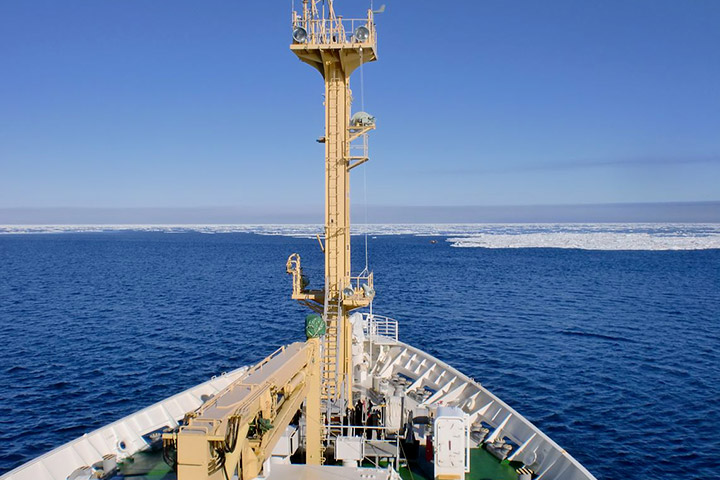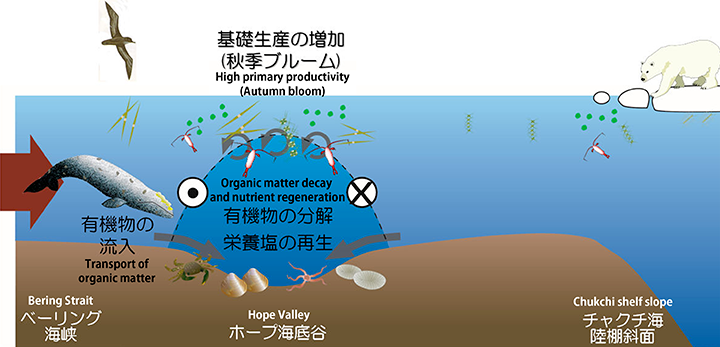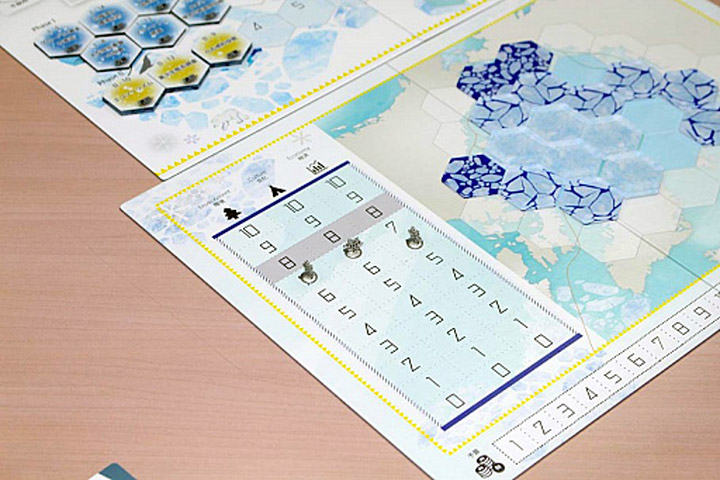Theme 4
Observational research on Arctic Ocean environmental changes

View of sea ice from the bow of R/V Mirai off Pt. Barrow, Alaska / Photo by Shigeto Nishino (JAMSTEC)
To understand the situation of environmental changes of the Arctic Ocean and assessing the lower trophic ecosystem and climatological impacts, four research groups in this theme conducted on-site observations mainly in the Pacific sector of the Arctic Ocean, by R/V Mirai along with other ships, time-series measurements of mooring systems, laboratory experiments, and numerical experiments. The research highlights of the theme are as follows:
1) We successfully collected time-series data on water temperature, salinity, dissolved oxygen, turbidity, and dynamics of zooplankton and phytoplankton activities by year-long mooring measurement. The data revealed that phytoplankton blooms occur not only spring when sea ice is melt, but even in fall. Nutrient generated by organic matter decomposition plays an important role to the fall blooms in the Hope Valley. Using the same mooring data, we also found that CO2 released during decomposition enhances ocean acidification at the bottom of the Hope Valley.
2) For better understanding of the impacts of rapid environmental changes on the Arctic ecosystem, we conducted shipboard experiments to examine the effects of temperature, CO2, and salinity on phytoplankton dynamics. Our results suggest that the smaller phytoplankton tend to dominate in the shelf edge region of the Chukchi Sea in the western Arctic Ocean under multiple environmental perturbations.
3) Satellite observation data of Synthetic Aperture Interferometric Radar Altimeter (SIRAL) were used to figure out the sea surface dynamic height (monthly average) that can define the geostrophic current, thereby unveiling the fact that changes of the Arctic Ocean circulation in winter. This result suggests that the sea surface dynamic height can be used to estimate the change in freshwater storage capacity in the seasonal sea ice zones.
4) The mooring observation using an ultrasonic water pressure gauge in the coastal areas of the northeastern Chukchi Sea enabled us to obtain time-series data on sea-ice draft. Using the data, we investigated the sea ice thickness distribution that is important for prediction but whose situation is still not sufficiently understood. This also clarified that the change in sea ice thickness can be affected by coastal polynya formed by predominantly northeast winds.

Autumn bloom in Hope Valley in the Chukchi Sea. Circles with a dot and x represent flows from the back to the face of the figure and from the face to the back of the figure, respectively.
It is also worth noting that we initiated and produced some results, such as applying the Value Tree Analysis (VTA), to encourage social and natural sciences for the Arctic. For public outreach of Arctic research, we were able to develop an Arctic educational tool (a board game named The Arctic) in collaboration with Themes 6 and 7.

Board game "The Arctic"
Research background and overview
Please see here.
Research achievements
Please see here.




